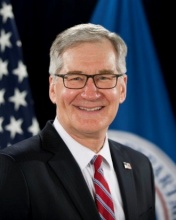
DHS components see sluggish progress on Unity of Effort
Managers within the Homeland Security Department's headquarters say the Secretary's "Unity of Effort" initiative is working better for them than it is for indiv...
Top-level managers at the Homeland Security Department say the secretary’s “Unity of Effort” initiative is driving change within the agency at large. But buy-in and progress from all of the department’s 22 individual component agencies is slow.
A recent report from the Homeland Security and Defense Business Council and Grant Thornton found that 83 percent of current DHS managers and employees felt the “Unity of Effort” was “essential” or “very important” to the overall department mission.
But 64 percent of respondents said the effort would have an impact on their individual agency’s mission.
Respondents say the reason for the lower confidence in the initiative is tied to little communication from the top, too many agency silos and a lack of a common goal. These are just some of the challenges components have faced since Secretary Jeh Johnson introduced the “Unity” initiative in 2014, the report said.
The disparity between DHS headquarters and its individual agencies starts with the mindset and morale of employees in the field, said Rear Adm. Mark Butt, acting deputy commandant for operations at the Coast Guard and chairman of the DHS Joint Requirements Council, at the Council’s Nov. 9 State of the Homeland Security Enterprise symposium in Washington.
“How does the marine inspector who’s inspecting a barge, relate to the DHS mission,” Butt said. “The fact is, if you look across the 16 critical infrastructures, the only one that DHS regulates is marine transportation systems. So that inspector is a key component of keeping one of the critical infrastructures of this nation going and functioning. Having a realization that our mission sets aren’t competing but are complementary to the DHS mission has allowed us to take another look and fully encompass where the secretary wants to go with the Unity of Effort.”
Daniel Ragsdale, deputy director of Immigration and Customs Enforcement and chairman of the Business Management Committee, said his group has tried to break down the silos individual agencies have built.
But the process hasn’t been easy.
When Congress first created the department in 2002, bits and pieces of ICE, Customs and Border Protection and U.S. Citizenship and Immigration Services were all part of one agency. Moving away from the past has been a challenge, said James McCament, acting deputy associate director for service center operations at USCIS.
“Our departments and agencies were a bit at odds with each other,” he said. “Yet in the intervening 12 years, we have had to struggle and wrestle with how do you do the day-to-day in the department, how do you understand how to meet the core mission needs of our respective agencies and at the same time do it in a way that reflects a unified department”
Now, 22 agencies — each with seemingly disparate missions — are slowly beginning to talk to each other and collaborate on buying products and services with a “DHS-first” mindset.
For example, the tools that special agents at USCIS use don’t differ drastically from the tools agents at ICE might need in the field, Ragsdale said.
“Because of the way our budget is built and the way the acquisition process works even internally, there may be a requirement that one person has on the right hand, that the left hand might not know about,” he said.
But rather than developing a contract and then buying those tools solely for USCIS, Ragsdale said he’s trying to approach the acquisition in a way that might benefit multiple component agencies.
Sustaining ‘Unity of Effort’ past 2016
With just about one year left of the Obama administration, component leaders worry the upcoming presidential transition could undo any progress that has been made in bringing the department closer together.
DHS has experienced similar “Unity” efforts in the past, usually when one secretary leaves and another takes his or her place.
Ultimately, the DHS mission itself should rise above the politics and personnel changes that come with a new administration, McCament said.
“We need assistance in getting the message [out] that these types of efforts completely transcend whatever happens partisan-wise and whatever happens for specific policies,” he said.
But McCament said the structures and working groups Johnson created under the “Unity of Effort” initiative, such as the Deputy’s Management Action Group and the DHS Joint Requirements Council, serve as a foundation for these programs to continue well past the next presidential transition.
To develop more continuity between administrations, Butt suggested the DHS secretary have the authority to appoint a specific career executive to direct the Joint Requirements Council and lead the “Unity of Effort” initiative.
Ragsdale suggested the department develop a business case with specific examples that show where the “Unity” has been successful.
“That will suggest that working together makes a lot more sense than working across purposes,” he said. “With that document in hand, even during a transition, the validity of the joint ‘Unity of Effort’… just makes good sense, particularly in a resource-constrained environment.”
Copyright © 2024 Federal News Network. All rights reserved. This website is not intended for users located within the European Economic Area.
Nicole Ogrysko is a reporter for Federal News Network focusing on the federal workforce and federal pay and benefits.
Follow @nogryskoWFED




